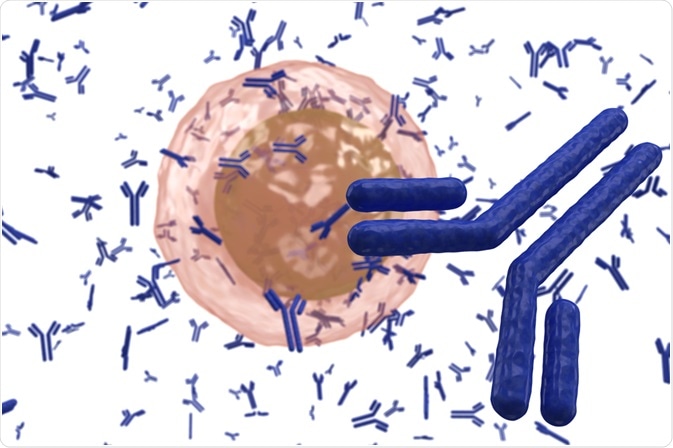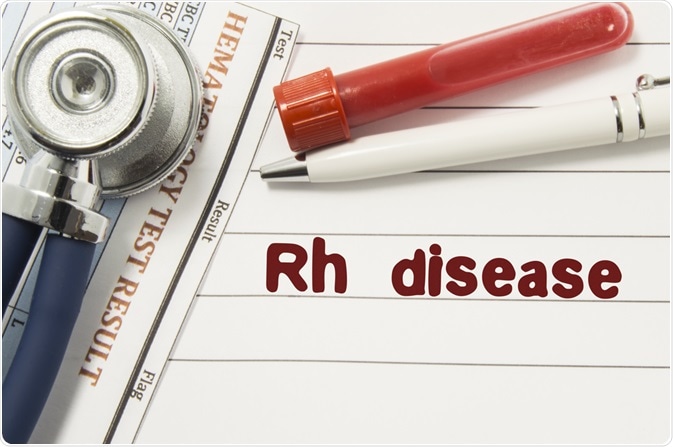A polyclonal antibody (pAb) is a collection of different monoclonal antibodies (mAbs) derived from different B cell lineages. Each antibody in a pAb collection binds a specific epitope on the same antigen, so it can increase sensitivity towards a specific antigen.

Image Credit: extender_01/Shutterstock.com
Characteristics of polyclonal antibodies
The heterogeneous nature of pAbs means that production can be relatively cheap to produce compared to mAbs. A common method of production can involve a mammal being injected with an adjuvant of the antigen several times over a few months.
This induces an immune response against the antigen, causing the animal to produce IgG antibodies that can later be extracted from the blood. A larger animal, such as a goat, is generally preferred to get a higher titer of antibodies.
Other methods of production include the use of mammalian cell lines to produce the desired antibodies at high quantities. Alternatively, in some cases, they can be directly derived from human blood plasma.
As different antibodies in the mixture can bind different epitopes of a target protein, pAbs are useful in capturing proteins in an immunological assay, for example in a sandwich ELISA. This increases the sensitivity of the assay for the target protein.
The ability to bind multiple epitopes of an antigen provides pAbs with a higher overall affinity for its target. This means they bind the target more quickly than a mAb would, so increasing their efficacy in medical applications. It is also useful in immunological assays that require proteins to be captured quickly, such as chromatin immunoprecipitation.
Where the protein structure is compromised due to heat or chemical-induced denaturation, or structural changes, pAbs are more likely to still be to bind the target. This is because one of the target epitopes may be still structurally intact.
A disadvantage of the heterogeneous mixture in a pAb is that the composition of the mixture can vary between batches. This may mean that a weaker immune response is induced, depending on the concentration of different antibodies in the mixture.
It is also less easy to predict the outcome of any immune response induced, as the multiple different antibodies can attract different types of immune cells initiating a highly complex response.
Uses in medicine
In addition to uses in biochemistry, pAbs have various pharmaceutical uses as specific drugs. They can act as immunotherapy for conditions where the treatment needs to be more complex than the use of a single mAb or bispecific antibody.
Certain heart arrhythmias are commonly treated by the drug digoxin, particularly atrial fibrillation and atrial flutter. Overdose can worsen arrhythmia, along with a variety of other side effects, and is likely in older patients.
Digoxin immune fab (DIF) is a polyclonal antibody that can be used to treat this cardiac glycoside toxicity. It consists of anti-digoxin IgG antibodies obtained from sheep inoculated with a modified version of the drug that removes its activity.
Digoxin binds a Na/K ATPase pump, which normally maintains a low concentration of sodium in myocyte cells. DIF binds digoxin at a higher affinity than digoxin binds to the pump, thereby decreasing the toxic effects of the drug.
Another example is rozrolimupab, a pAb used to prevent Rh disease. This can occur in the offspring of certain Rh-D negative women, maternal antibodies against the D antigen initiate a passive immune response in the fetus or newborn killing immature red blood cells where the offspring is Rh-D positive.
Rozrolimupab consists of 25 unique anti-D IgG antibodies, this heterogeneity allows it to closely replicate the natural human response to the disease. It is often used as a preventative measure both during pregnancy and after birth in Rh-D negative women with Rh-D positive biological fathers.
The individual mAb antibodies used in rozrolimupab are derived from CHO cells and can be produced in high quantities with replicable specificity. They provide similar efficacy to plasma-derived pAbs and have been shown to have been safer and more tolerable.

Image Credit: Shidlovski/Shutterstock.com
Conclusion
Further research in the application of polyclonal antibodies may help to solve various complex illnesses, where pAbs could help to initiate a more intricate immune response or bind to a substrate present at a very low level in the body.
pAbs have been touted as a potential tool against coronavirus, either as prophylaxis or preventative medicine. Current efforts have focused on developing pAbs against MERS-CoV, with a phase I clinical trial being completed in 2016.
This showed the cattle-derived pAb SAB-301 to be safe for use in humans but using pAbs in the current COVID-19 pandemic would be very unlikely as a finished product would be many years away. However continued research into the use of polyclonal antibodies against certain viral infections may be useful in future coronavirus outbreaks, or similar.
Monoclonal antibodies vs Polyclonal antibodies
References
- Beigel, J. H. et al. (2018) ‘Safety and tolerability of a novel, polyclonal human anti-MERS coronavirus antibody produced from transchromosomic cattle: a phase 1 randomized, double-blind, single-dose-escalation study’, The Lancet Infectious Diseases. Lancet Publishing Group, 18(4), pp. 410–418. doi: 10.1016/S1473-3099(18)30002-1.
- Hassan, S. A., and Goyal, A. (2020) Digoxin Immune Fab, StatPearls. StatPearls Publishing.
- Jean, S.-S., Lee, P.-I. and Hsueh, P.-R. (2020) ‘Treatment options for COVID-19: the reality and challenges’, Journal of Microbiology, Immunology, and Infection. Elsevier BV. doi: 10.1016/j.jmii.2020.03.034.
- Pacificimmunology.com (2020) Polyclonal vs Monoclonal Antibodies. Available at: https://www.pacificimmunology.com/resources/antibody-introduction/polyclonal-vs-monoclonal-antibodies/ (Accessed: 25 April 2020).
- Robak, T. et al. (2013) ‘Rozrolimupab, a mixture of recombinant human monoclonal anti-D antibodies, for the treatment of primary immune thrombocytopenia - a review’, ISBT Science Series. Wiley-Blackwell, 8(1), pp. 102–108. doi: 10.1111/voxs.12050.
Further Reading
Last Updated: Sep 11, 2020